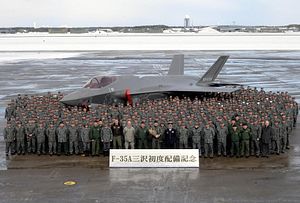The Japan Air Self-Defense Force (JASDF) said on August 10 that pilot vertigo was the reason one of its fifth-generation Lockheed Martin Lightning II F-35A Joint Strike Fighters crashed into the Pacific Ocean off northern Japan four months ago.
An investigative report published by the JASDF today concludes that “spatial disorientation” on the part of the pilot and not any mechanical failure caused the accident on April 9. This confirms the findings of an interim report published by the service in June.
The crashed Joint Strike Fighter was one of four F-35As that took off from Misawa Air Base for a training mission at 6:59 p.m., Japan time, on April 9. The pilot, Major Akinori Hosomi of the 3rd Air Wing’s 302nd Tactical Fighter Squadron, engaged in aerial combat training and shot down two enemy aircraft in a simulated dogfight as part of the mission, according to report’s findings.
JASDF ground control told the pilot to descend around 7:26 p.m. to maintain its distance with a U.S. military aircraft some 36 kilometers away. The aircraft disappeared from radar tracking systems at 7:27 p.m. a few seconds after the pilot’s last message was received.
The F-35A crashed into the Pacific Ocean at more than 1,100 kilometers per hour (683 miles per hour) with no reported attempt by the pilot to avoid a collision. The crash occurred about 135 km (84 miles) east of Misawa Air Base, in the northern part of Japan’s main island of Honshu. There is no evidence that the pilot managed to eject from the cockpit before the aircraft hit the water.
The August 9 report does not elaborate on how JASDF investigators and outside experts reached their conclusion. The interim report published in June relied exclusively on pilots’ testimonies and data and communication received by ground controllers. A Japanese search team managed to recover parts of the F-35A’s flight data; however, it was reportedly too heavily damaged to yield any data about the cause of the accident.
Notably, only the crashed F-35A’s tail was found drifting on the ocean’s surface. The aircraft’s fuselage continues to be missing. Japanese search teams were also not able to retrieve all of the remains of the pilot. Hosomi was officially declared dead at the beginning of June.
As a result of the crash all JASDF F-35A pilots have undergone extra vertigo training as well as additional instructions for nighttime flights and various emergency situations. All future F-35A pilots are slated to undergo these additional trainings.
The Japanese Ministry of Defense (MoD) announced last week that the JASDF had resumed training flights with its F-35As. The entire fleet had been grounded following the April 9 accident. The announcement was preceded by the service’s 12 F-35As undergoing additional technical checkups over the last four months.
































